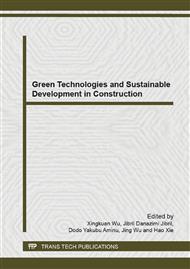[1]
G. Kanat, Municipal solid-waste management in Istanbul, Waste Management, vol. 30, no. 8–9, p.1737–1745, Aug. (2010).
DOI: 10.1016/j.wasman.2010.01.036
Google Scholar
[2]
I. Ajzen, Perceived Behavioral Control, Self-Efficacy, Locus of Control, and the Theory of Planned Behavior1, Journal of Applied Social Psychology, vol. 32, no. 4, p.665–683, (2002).
DOI: 10.1111/j.1559-1816.2002.tb00236.x
Google Scholar
[3]
Green Building Council of Australia. (2003), www. gbcaus. org.
Google Scholar
[4]
S. Barr, Factors Influencing Environmental Attitudes and Behaviors A U.K. Case Study of Household Waste Management, Environment and Behavior, vol. 39, no. 4, (2007) 435–473.
DOI: 10.1177/0013916505283421
Google Scholar
[5]
P. Tucker and P. Douglas, WR0112: Understanding Household Waste Prevention Behaviour. " A project for Defra, s WREP*, (2007).
Google Scholar
[6]
R. A. Begum, C. Siwar, J. J. Pereira, and A. H. Jaafar, Attitude and behavioral factors in waste management in the construction industry of Malaysia, Resources, Conservation and Recycling, vol. 53, no. 6, pp. (2009) 321–328.
DOI: 10.1016/j.resconrec.2009.01.005
Google Scholar
[7]
R. East, Investment decisions and the theory of planned behaviour, Journal of Economic Psychology, vol. 14, no. 2, (1993). 337–375.
DOI: 10.1016/0167-4870(93)90006-7
Google Scholar
[8]
J. Davies, G. R. Foxall, and J. Pallister, Beyond the Intention–Behaviour Mythology An Integrated Model of Recycling, Marketing Theory, vol. 2, no. 1, (2002) 29–113.
DOI: 10.1177/1470593102002001645
Google Scholar
[9]
T. C. Kelly, I. G. Mason, M. W. Leiss, and S. Ganesh, University community responses to on-campus resource recycling, Resources, Conservation and Recycling, vol. 47, no. 1, (2006) 42–55.
DOI: 10.1016/j.resconrec.2005.10.002
Google Scholar
[10]
M. Tonglet, P. S. Phillips, and A. D. Read, Using the Theory of Planned Behaviour to investigate the determinants of recycling behaviour: a case study from Brixworth, UK, Resources, Conservation and Recycling, vol. 41, no. 3, (2004) 191–214.
DOI: 10.1016/j.resconrec.2003.11.001
Google Scholar
[11]
J. Arbuckle, Amos 6. 0 user's guide. Chicago, IL: SPSS, Inc, (2005).
Google Scholar
[12]
G. A. Marcoulides and R. E. Schumacker, Advanced structural equation modeling: Issues and techniques, vol. vii. Hillsdale, NJ, England: Lawrence Erlbaum Associates, Inc, (1996).
Google Scholar
[13]
P. O. do Valle, E. Reis, J. Menezes, and E. Rebelo, Behavioral Determinants of Household Recycling Participation The Portuguese Case, Environment and Behavior, vol. 36, no. 4, (2004) 505–540.
DOI: 10.1177/0013916503260892
Google Scholar
[14]
M. -F. Chen and P. -J. Tung, The Moderating Effect of Perceived Lack of Facilities on Consumers' Recycling Intention, Environment and Behavior, vol. 42, no. 6, (2010) 824–844.
DOI: 10.1177/0013916509352833
Google Scholar


